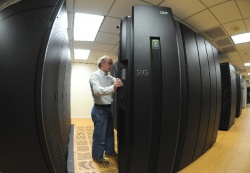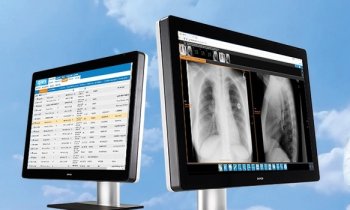The growing need for ‘cloud’ computing
In June 2009, IBM introduced the industry’s first set of commercial cloud services. Based on two years of research and hundreds of client engagements, the IBM Smart Business ‘cloud’ portfolio aims to help clients turn complex business processes into simple services.
How does IBM explain what cloud services are? Cloud Computing is a form of IT use where the end user can utilise applications, data and IT infrastructure components in the form of services, the company explains.


Based on the cloud there is access to numerous services, from business applications via collaboration tools, social networking and email systems to software development platforms, test environments, data back-up and technical applications. Essential features of Cloud Computing:
• Variable costs: Usage-dependent payment and subscription models, flexible pricing and minimal fixed costs.
• Complete scalability: Applications and infrastructure can be added, removed, changed, enlarged or reduced.
• Automated availability: Capacities and resources are made available at short notice.
• Highly developed virtualisation: Facilitates independent, efficient infrastructure.
• Ubiquity: The Cloud can be accessed via the internet at any time from any location on any machine with a browser
• Easy utilisation: Users can request services via a self-service portal
‘Our healthcare systems suffer a multitude of problems, and all of them have the same cause: Our healthcare system is no system,’ IBM states. ‘Exploding costs, errors in treatment, bureaucracy, long development cycles for new drugs – these and others problems could be solved if all those involved in the process were networked in a better way.’
Exchanging essential data more efficiently, gaining more insights from this data whilst consistently putting the patient at the centre of things – this is the key to a more intelligent healthcare system.
A ‘smart’ system like that collates data from all imaginable sources – and lets the patients decide which information is available in which place. For example, the Medical University Hannover uses RFID technology to improve processes, reduce waiting times and thereby improve the quality of treatment for patients. In Denmark, innovative approaches to the remote monitoring of patients’ health in real-time are on trial so that older patients can live at home for longer and gain quality of life.
A smart healthcare system can consolidate all these data: At the Canadian research clinic Sainte Justine examination data typically available in different departments are automatically collated, administered and updated. This simultaneously speeds up research, improves treatment and lowers costs. In Spain the healthcare service Servicio Extremeño de Salud has introduced an integrated system that provides the doctor in charge of treatment with the complete, updated patient file every time – notwithstanding which one of the numerous regional treatment centres a patient attends.
A smart healthcare system can consolidate different data reliably into usable knowledge.
IBM supports a number of world-famous universities in their endeavours to develop a global network of medical data. This would give doctors a diagnostic store of knowledge at their disposal that, up until recently, was unimaginable.
All these solutions have potential far beyond their current regional or medical radius. In a networked, intelligent system, good ideas can quickly spread. The result: falling costs, increasing quality of treatment and a healthcare system which really does make things better for the individual and society – as it now really deserves the term ‘system’.
Some examples:
The Japanese watch their waistline – and this also goes for the Government
A new law dictates that citizens aged between 40 and 74 must have their waistline measured during their annual medical check-ups. Those whose measurements exceed specified limits are given dietary recommendations and further advice on losing weight.
Whether or not these regulations should be viewed as surveillance medicine or simply regarded as a proactive wellness strategy – at least they are a pointer towards the future: The solutions for healthcare systems have to change the world over. Tools such as electronic patient files, mobile, handheld computers and support networks can make the healthcare system more intelligent.
Indeed, an intelligent healthcare system is predominantly not geared towards the next breakthrough in medical research. Intelligent healthcare solutions start with the individual. Take, for instance, the American model ‘Medical Home’. GPs there act as ‘trainers’; they head up a team which looks after the well-being as well as preventative and chronic care of the patient. The doctor spends more time with each person, is contactable via email and telephone for consultations, offers enhanced surgery hours and coordinates the deployment of the entire care team.
Better healthcare at home
Almost 900,000 Canadians are regularly looked after at home and this number is on the increase. From 1995 to 2002 the number of people being cared for at home has risen by more than 60%.
The Victoria Order of Nurses (VON) (US) is Canada’s largest, national non-profit organisation for home and community care. IBM will equip VON with novel business processes and clinical technologies, amongst others with mobile, wireless handheld computers. The system will support several hundred home care providers in the following areas:
• Scheduling of patient appointments
• Capture, transmission and recall of patient data in real time
• Access to staff- and service administration
• Automation of finance- and billing processes
This transformation will integrate the 52 VON locations in Canada more strongly and will make them more cost-efficient, which benefits community services and patient care.
Control over medical history
For more than a decade now Google has been perceived as a worldwide source of information on health. Now Google, IBM and Continua Health Alliance (US) have formed a partnership which makes it possible for individuals to create their personal health profile. This consolidates data on medical complaints, allergies and illnesses.
The partnership even allows users to import files and medical histories from hospitals, laboratories and pharmacies. Two examples:
• Busy people can electronically check on the current state of health of an elderly parent living on their own, suffering from high blood pressure and being prescribed several types of medication, all on a daily basis
• Business travellers who are suffering from diabetes and are training for a marathon can talk to their trainer in real-time about their blood sugar levels and heart rate, all across distances of hundreds of kilometres
What else can we expect from an intelligent healthcare system? At the centre of an intelligent healthcare system is increasing, personalised experience.
Information is not distributed across desert islands
An intelligent healthcare system is networked. The Spanish Servicio Extremeño de Salud (SES) (US) where every individual location used to have their own patient file system took action and developed a global platform which networks almost 13,000 staff through a planning system which administers nine million outpatient visits a year.
Know-how requires no passport
An intelligent healthcare system does not stop at geographical borders. Take the example of the island of Tristan da Cunha (US). It is situated more than 2,665km west of Cape Town, South Africa, and is only reachable via a long journey by sea. However, this does not mean that its inhabitants have no access to high quality healthcare and medical technology. Project Tristan links medical equipment, satellite communication and EHR technology connected via remote access. Medical experts from all over the world can support hospital doctors on the island in their daily tasks with regards to medical diagnoses and emergency aid.
Feature source: IBM
02.03.2010











